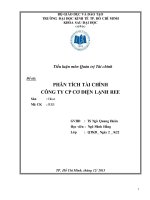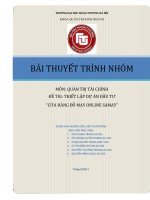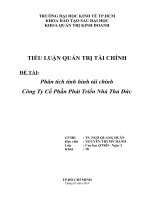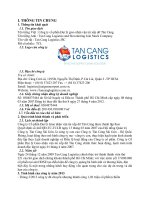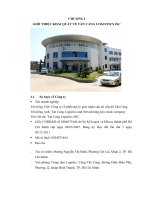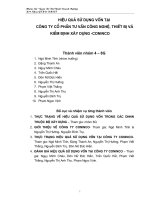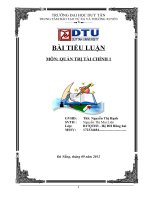tiểu luận quản trị tài chính investment project HADIGO STORE
Bạn đang xem bản rút gọn của tài liệu. Xem và tải ngay bản đầy đủ của tài liệu tại đây (3.12 MB, 19 trang )
I. A DESCRIPTION OF THE PROJECT
1. Preface
Pollution problem has been no longer strange to any of us. We all know that
hundreds of “garbage patch” has been created all over the world, especially
along the coast, on the floor of the ocean and underneath the surface. We
also know that it takes at least 400 years to disintegrate a plastic item, like
packaging and straw which is often used for very short period before being
discarded. It is a fact that within 100 years since the Second Industrial
Revolution happened, about 8.3 billion tons of plastic garbage has been
discharged to the planet – an amount equals to 25,000 Empire State Buildings
in New York, or a billion elephants.
We definitely do not want to live on a Planet Plastic so it is high time we start
replacing plastic by other type of material, using products which are made
from environmentally friendly ingredients. This is the idea driving us to
establish “HadiGo” – a green store where you can make some simple
changes with eco friendly products that can have big impacts on your
environmental footprint. What we sell are eco friendly products, and at our first
stage, we focus on launching and improving our first product line: Tomato
Lady. After 1 year of operating, we plan to extend the diversity of our products
by providing more non-plastic and eco-friendly products to customers, from
plates, bowls, take away containers and cups made from bamboo and
sugarcane, which can be easily disintegrated; glass and metal straws which
can be reused for a long time, to designed tote bags which can be convenient,
fashionable and environmental - friendly.
Ultimately, our aim is not only to sell eco-friendly products, but also to create a
‘green’ lifestyle, to give a green solution to our beloved customers. We hope
that the waste water from sinks, toilets, drains of each small family will
become cleaner, reduce environmental pressure for polluted rivers and
streams, and increase balance regenerated ability. We would like to
accompany and cooperate with individuals, social organizations, state
agencies to join hands in restoring our harmony with nature.
We believe that labor must be associated with the joy of life and the joy of
creativity. We aim towards product’s true quality. Each and every product
makes love and knowledge blossom form within our growers, researchers,
producers, distributors, and consumers.
2. Mission Statement
From the origin of idea, we have devoted our energy and our competencies
solely to one business: environment. This business is worth in meaning, as it
enables all individuals to realise how important of the planet to themselves,
and turn this awareness into action by saving the planet in every single activity
in their daily life. HadiGo has set itself the mission of offering all women and
men in Vietnam sustainable products which are totally made of eco-friendly
materials in terms of quality, efficacy and safety by meeting the infinite
diversity of daily needs and desires all over the country. We not only hope to
gain profits for our stakeholders through efforts of running this business, but
more than that, we also strive for giving our customers creative, discarding
plastic items, and a great experience in changing into a green lifestyle.
3. Description of “Tomato Lady” Products
Tomato is a micronutrient-rich product that is extremely available in Vietnam.
After making fermented, Tomato is left with residue and be ready to mix with
microorganisms to create fertilizer that 100% in harmony with the
environment.
1. Fragrance: A product that uses natural essential oils for a gentle,
delicate scent.
2. Cleaning by microbiological fermentation instead of surface abrasion.
3. Support deodorizing, sterilizing, especially adding anti-fungal
ingredients.
Because it is made from fermented microbiological herbs, the waste water
from the washbasin, the washing machine or toilet will go out harmlessly. If it
is used by many households, the microorganisms will clean public sewers,
wastewater will be cleaner, eliminate odors.
2
The product does not only clean during usage but only continue to clean
clothes, floors and appliances after use because of the ongoing fermentation
mechanism.
TOMATO LADY consists of 6 products:
● Ms. Tomato hand washer
● Ms. Tomato dish washer
● Ms. Tomato floor cleanser
● Ms. Tomato cloth washing (soak 30-60 minutes before washing)
● Ms. Tomato Super Clean (clean multi-purpose appliances)
● Ms. Tomato Toilet Brush
3
II. SWOT ANALYSIS
Table 1: SWOT
1. Strengths
2. Weaknesses
● High-quality and well-designed ecofriendly products.
● Having a wide variety of product line
that can satisfy the needs of different
customer segments.
● Being in the initial introduction phase;
taking time and effort to educate target
customers
to
change
their
consumption habits.
● Haven't
received
strong
brand
● We have ourselves a sales team and
customer care. They are loyal
customers, they believe in us, believe
in the services we provide. That is the
foundation, the system makes a
difference.
recognition and reputation yet.
● Have limited budget, service lines,
management experiences and human
resources.
3. Opportunities
● Consumers, especially young people,
are taking into account environmental
protection seriously and are aware of
how their own actions affect the
environment
● As
income
and
consumer
consciousness
improve,
green
consumption trends are becoming
more
common
in
developing
countries, particularly in Vietnam.
● The market volume is very
potential in the current time.
Only few businesses jump into
eco-friendly products sector → a
4. Threats
● Large businesses like Unilever can
launch similar products or launch
products that are less harmful to
human health and the environment.
They
can
also
enter
green
manufacturing. Or giants may find
ways to destroy small businesses.
● Once green products have become
popular in supermarkets and stores all
over the country, it is difficult for our
businesses to sell such products.
● Competition with many businesses
provides similar services but they have
more resources.
promisingly opportunity of doing
4
business
in
green
products
stores.
III. MARKETING MIX
1. Product
What we bring to the customer is not products, we bring green solution to the
customers in which its nature is services. However, green solutions do not
meet the customers’ need, so our products must have good quality and meet
the customer’s needs and satisfaction.
We innovate everyday, we change, we create to develop our products and
services to be more perfect. And diversification of them is essential to satisfy
the customers from low level to the high level.
2. Price
We set the price as listed on the market by manufacturers. However, we would
have discount campaigns and incentive policies to attract customers.
3. Place
Products are sold on the ecommerce platform, stores and direct sales system.
Customers can enjoy shopping with just a smartphone and access the store's
address on e-commerce sites. Customers can shop directly at the store. And
especially, we have a sales team specializing in distributing, selling products
and serving customers to each household.
4. Promote
5
Table 2: Promotion Plan
Constructing
Developing
Objectives Build trust and win customers' Develop businesses and
trust.
Make
our
market dominating
Hanoi
construction
and
reach market.
potential customers. Building a
sales system and creating a
loyal customer database.
Timeline
From Jan to Dec 2020
Activities
● Establish
Leading
Expand
business
scale,
establish facilities across
provinces
and
cities
nationwide and lead the
market in the distribution
industry,
provide
green
products, green solutions.
From Jan 2021 to Dec From 2023 to 2030
2022
e-commerce ● Develop 3 business ● Launch 10, 20, 50 and
presences.
● Build
brand
100 branches throughout
sale
the country.
communicating content.
teams
both
in ● Clone sales teams.
● Establish and promote
quantity and quality.
● Promote communication
● Promote marketing,
sales teams.
and marketing networks.
● Build
and
units in Hanoi
and ● Develop the
improve
customer services.
● Diversify products
services portfolio
KPIs
and
direct and indirect
communication
through direct sale
team, advertising on
e-commerce
interfaces.
30 salesman
400 salesman
1,000 salesman
1,000 customers
12,000 customer
1,000,000 customers
6
IV. FINANCIAL ANALYSIS
1. Assumption
The financial plan depends on important assumptions, most of which are
shown in the following table as annual figures. The key underlying
assumptions are:
Table 3: General Assumption
Year
1
2
3
Tax rate
15%
17%
17%
Cost of equity
50%
50%
50%
● Based on the average index of Vietnamese retail industry provided by
Viet Capital Securities (VCSC) in 12/2019 (31,18%), we assume that cost
of equity of our project would be 50%, which is marked up 18.82% in
order to cover our risk.
● A slow growth economy, without great recession.
● Growth and cash flows will be moderate.
● Future cash investments will use NPV projections to achieve maximum
return with limited risk.
● There is no inflation or any changes in interest rates, or inflation is fully
anticipated. This is a reasonable initial assumption, and it can be
modified.
● There is an increasing interest of customers when we launch new project.
● Our sales team can work effectively with a specified sales growth rate.
● Our company will remain in business for the foreseeable future.
● We assume our fiscal year starts from January 1st 2020.
● All the money figures are in Thousands VND (1,000 VND).
● Our financial forecasting would be carried out in the monthly basic for the
first year, and then annually for the next two years.
For others specific assumptions, we will show them in each related part below.
7
2. Initial Investment
At a very first stage, we have already made use of our personal venue as a
warehouse, therefore minimizing the storage cost. We have to invest in tools
for management, in this case we will purchase a laptop for the CEO, which
would be the long term asset of our company. This asset would be
depreciated each year using straight line method, without salvage value.
We would contract an outsourcing service in constructing our brand
foundation. This package will consist of logo design, webshop, sales
management software, etc.
Table 4: Initial Investment
Assets
Value
Lifetime
Brand Foundation
Package
20,000
Infinite
Laptop
20,000
10
Depreciation per year
2,000
3. Fund Raising
Our final initial investment is about VND 100 million. The calculations in our
financial analysis assume that we use 100% equity to finance this project. This
is a long-term project, which is reevaluated after every three years.
4. Incremental Earnings Forecast
a. Revenue
Our project has only one source of revenue, which comes from selling
products (we act as a wholesaler).
According to our actual business results in the first month, our revenue is
mainly from performance of the sales team. In the first launched month this
team has 5 people, each salesman has an average of 30 products in sales.
8
We assume that there would be 2 new salesman hired each month, and the
sales growth rate would be stable as describing in the table:
Table 5: Direct sales (Product)
Month
1
2
3
4
5
No. of Salesman
5
7
9
11
13
Product sold per Salesman
30
40
48
58
69
KPI - sales growth rate
0%
33%
20%
20%
20%
No. of product through
direct sales
150
280
432
634
899
6
7
8
9
10
11
12
15
17
19
21
23
25
27
83
91
100
110
121
134
147
20%
10%
10%
10%
10%
10%
10%
1,244
1,551
1,907
2,318
2,793
3,340
3,967
Total
19,515
In addition to build our sales team, we would participate in about 2 events
(start up exhibition, competition, fair, etc) each month, which mostly free to
register, in order to promote our brand image to the customers. Sales from
those kind of events would increase the number of products sold by 20 units
each month.
9
Table 6: Cumulative product growth
Month
1
2
3
4
5
No. of product through
event
20
20
20
20
20
No. of product through
direct sales
150
280
432
634
899
Total
170
300
452
654
919
6
7
8
9
10
11
12
Total
20
20
20
20
20
20
20
240
1,244
1,551
1,907
2,318
2,793
3,340
3,967
19,515
1,264
1,571
1,927
2,338
2,813
3,360
3,987
19,755
We assume that the number of products sold would be counted in the whole
number at the end of the month. The average price per product in the first
month is nearly 70,000 VND. Because we plan to keep the same product
portfolio in the first six months, and then broaden our product range in the next
2-year period. So, the average price per product would be 70,000 VND and
150,000 VND in the two periods, respectively.
Also, we assume that revenue rowth rate in 2nd year nearly equal to the
average growth rate of the VN retail industry in 2018 - 11%. The revenue
growth rate of the 3rd year will be 11% plus 30% due to expansion. Thus, the
estimated revenues would be as the following table:
10
Table 7: Estimated Revenues
b. Cost of Good Sold
Due to the nature of the wholesaler in general and our project in particular,
cost of goods sold for this project is the cost of purchasing inventory.
Table 8: Supplier’s Credit Term
Liter
100 - 300
300 - 500
500 - 1000
> 1000
Equivalent No. of product
200 - 600
600 - 1000
1000 - 2000
> 2000
35%
40%
45%
55%
Credit Term
We apply our current credit term of Co Ca Chua products to assume COGS
rate of the first six months. After we broaden our product portfolio, the credit
term could be higher, up to 55% for the next six months, and would go down
to 50% in the 2nd and 3rd year due to our economies of scale.
The COGS would be added 1% of delivery cost. Thus, the COGS for the
three-year period would be as the table below:
11
c. Expenses
Table 9: Cost of Goods Sold
We plan to do business mainly online and through our sales team in the first
year. After that, we intend to invest in a physical store in the 2nd year and
scale up the business model the year after. Therefore, our expenses for the
next 3-year period would be shown in the following parts:
● Salaries and Wages
Salaries of sales team still extract from the revenue and the commision rate is
20% for every product, the fixed wage is 1.000.000 VND per salesman. We do
not have to pay shopkeeper wages until we open physical store in the 2nd
year.
We assume that our co-founder team (3 people) would be in charge of
marketing (coordinator, content writer, designer), operation, finance and
management and receive salaries for those tasks.
Table 10: Salaries and Wages
12
● Sales and Marketing
The marketing budget for this period is prepared mainly for Facebook Ads.
The detailed budget is shown in the following table:
Table 11: Sales and Marketing
● Rental and Additional Investment
The rental fees are paid for the physical store operated in the 2 nd and 3rd year,
and we have to invest in additional equipments (Point of Sales Material –
POSM) to set up this kind of business. We assume that those assets would be
depreciated in 5 years, using straight line method, without salvage value.
We would use our venue as a warehouse for the first 4 months to minimize
storage cost, after that, we would hire a bigger warehouse to match with our
scale.
Table 12: Rental Expenses
Moreover, to maintain our sales team’s effectiveness, we would hold a sales
training course once a month. The training budget would be increased
proportionately with the revenue.
Based on these assumptions above, the incremental cost would be as the
following table:
13
Table 13: Incremental Cost
d. Depreciation
Based on our assumptions, our depreciation figures are as following:
Table 14: Depreciation
e. Inventory and Account Payable
We assume that:
14
In the first year, inventory at the beginning of the month equals to
COGS for this month.
Inventory turnover of the 2nd and 3rd year would be 12 (average
inventory turnover of retail industry in 2018: 13.56 - According to
Investopedia.com, reduced by 1.56).
Supplier’s credit term is 3 months, delivery cost (1% revenue) must be
paid at delivery.
Table 15: Inventory
Table 16: Account payable
g. Incremental Earnings Free Cash Flow
We assume that: Inventory of the 1st month in the 4th year is equal to that of
the 12th month in the 3rd year.
The incremental earnings free cash flow is presented in the table below:
Table 17: Incremental Earnings Free Cash Flow
15
16
5. Financial Indicators For Project Appraisal
a. Net Present Value
We use the Incremental Earnings Free Cash Flow and the cost of equity as
the assumed discount rate to calculate NPV.
We have:
NPV = 1.246.867.000 VND
Due to the lack of similar projects, we cannot compare this NPV with that of
others.
b. Sensitivity Analysis
We examine the change of NPV based on the change of one of the following
factors:
Table 18: Sensitivity Analysis
Based on the sensitivity analysis, we have found that the main factors which
affects our performance could be revenue growth rate and the cost of equity.
Because the cost of equity is significantly difficult to manage, we will focus on
maintaining our revenue stream and carefully plan budget for sales &
marketing activities in order to keep the revenue growth rate stable.
17
c. BEP Analysis
We calculate the Break Even Point (BEP) of our project based on:
● All the figures are estimated within 3-year period.
● All the numbers are calculated by the par value.
● The average price of our product is calculated by the weighted average
method.
● The average cost is subtracted from operating activities.
Table 19: BEP Analysis
Based on our calculation, the Break Even Point in Time is nearly 10 months,
which is a very optimistic number. The reasons for this miracle capital
recovery are:
● Our business is a service company, which has lower proportion of fixed
expenses in the total overhead.
● We have a very positive figure in revenue forecasting, due to our new and
rapid growth industry (niche market - green product).
18
V. CONCLUSION
With an overall picture of finance and development plan, this project is
feasible with an initial capital of not more than VND 100 million. Due to the
nature of our products that provide services, the cost is not too great. The
sensitivity analysis above showed that in many situations including the best
case and the worst case, NPV is still higher than 0. Because our project is
launched to catch up with the upcoming trend in environmentally friendly
products, this could be a great success in the long run if we could keep our
revenue stream stable by applying strategic plan and risk management
effectively.
19
